Review of the Nordisk Oppland 3SI
 Following our 2017 tour in Denmark where we had an unfortunate encounter with a cat and its very sharp claws which put 37 holes in the flysheet of our Nallo 3GT. We had a decision to make, we had made repairs with tape however a permanent repair was out of the question as coupled with the holes that the sheep had put in it in Norway 2 years ago it would have meant replacing too many panels in the fly sheet which wasn't financially viable. We decided to look for another tent with the following criteria:
Following our 2017 tour in Denmark where we had an unfortunate encounter with a cat and its very sharp claws which put 37 holes in the flysheet of our Nallo 3GT. We had a decision to make, we had made repairs with tape however a permanent repair was out of the question as coupled with the holes that the sheep had put in it in Norway 2 years ago it would have meant replacing too many panels in the fly sheet which wasn't financially viable. We decided to look for another tent with the following criteria:
- light weight.
- a large vestibule porch with enough room for gear storage.
- the ability to be able to sit up inside the inner tent comfortably.
- strong and stable construction.
- easy access in and out.
With our experience of the Nordisk range with the Telemark 2 we looked at their range of tents. We decided on the Oppland 3SI as it met all the above criteria.
Oppland 3SI Review
Construction
Well having used the Nordisk Telemark 2 (review here) which we are very pleased with we kind of knew what to expect with this tent. Like all Nordisk tents the quality of construction is very good and the quality of the stitching is excellent throughout the tent. The Nortech fabric of the outer tent is lightweight but incredibly strong, here is what Nordisk have to say about the fabric:
Where the PU coating is applied to the surface of the fabric, the lighter SI coating penetrates the fabric so it can’t peel off. Therefore the SI coating actually adds strength to the fabric, and compared to PU the much more elastic SI coating actually has a much higher tearing strength.
As SI coating is ‘hydrophobic’ it naturally repels water, so when it rains all the water stays on the surface where a quick shake will get rid of almost all of it – and only a few minutes in the wind or sunshine will dry the tent completely.
Since SI coated fabric can not be taped, the Nordisk SI tents are specially designed with folded seams and expanding threads that expands when wet to avoid water penetrating the seams. However, it is still recommended to add seam sealer on the seams for improved waterproofness. SI coating is very dependent on the coating technique, which differs from brand to brand. Nordisk only use European silicone which is applied in three layers on each side.
Although Nordisk recommend seam sealant on the seams we haven't as yet added this and having used in some very heavy rain we haven't see any real signs of any of the seams leaking.
The inner tent is made from Nortech breathable nylon which being yellow gives a nice bright feeling to the tent. The doors and vents of the inner tent have 'No-See-Um' nets to prevent the ingress of insects and are even small enough mesh to prevent attack from the minute Scottish midge!
The groundsheet of the inner tent is Nortech nylon which is PU coated and all the seams are taped.
Polyurethane coated fabric is coated on one side of the fabric, normally on the ‘inside’. PU coating is not as flexible as SI coating and has a lower tear strength, but with a PU coated tent the seams of the tent can be taped making the tent as close to waterproof as can be.
As the PU coating might stick to itself and eventually break off if you pack it up wet for a very long time, it is important to dry up the tent before packing and storing it.
The pegging and guying points are generally very strongly constructed, however I would prefer a bit more reinforcing on the main pegging points as there are slight signs of the stitching holes stretching slightly although I don't think this will cause the pegging points to fail.
Footprint
There is a footprint available as an extra accessory for the Oppland 3Si and we would highly recommend getting it. Yes it will add another 774g of weight to your load but is well worth getting. Not only will it give you some excellent extra protection to the base of the inner tent from damage (see what happened to the footprint of our Terra Nova Quasar here) but it makes the vestibule a nice clean dry storage area for all your gear. Another good reason to have a full footprint covering the vestibule is that it can stop 90% of the moisture from coming out of the ground and causing condensation. We made a modification to the foot print by unpicking a seam that was helpfully just across where the front door is and then sewing on some Velcro. This made it easy to pull it apart so that we can place the stove on the grass in the door way so that we can cook in bad weather.
Pitching
Pitching the Oppland 3SI is extremely quick and easy and can be done by one person although with 2 people it makes it much quicker and easier. The shock corded 8.5 mm aluminum DAC Featherlike NSL poles are quick to assemble and are colour coded. With the longer mid pole being silver and the other two gold so there is no chance of mixing them up. The continuous pole sleeves make it simple to slide the poles in from one side and into the strap eyelets keeps before tensioning them with the easy to adjust straps. Only 4 pegs are needed to initially peg out and erect the tent before going around and pegging out the 8 guy lines. With the inner tent and footprint attached we can have our Oppland 3SI up and pegged out under 4 minutes.
Packing
Striking the tent is also again fairly easy, all the pegs from the guy lines can be removed bar the four key pegging points at the ends whilst the guy lines are tied up. The pole tensioners can then be released and the poles released from their keeps and the 4 remaining pegs removed to collapse the tent. The poles are removed easily although it helps to push them through from the other side rather than pulling them which can cause the poles to come apart. The outer tent, inner and footprint can easily be rolled up together which then makes it much easier to re-pitch later. We can pack the tent in under 4mins.
Both the footprint or the inner tent can be disconnected from the outer easily should you wish to pack them away away separately if they are wet.
Performance
As far as we are concerned this a great tent, you get a great deal of space for the weight. After the Nallo 3GT the Oppland 3SI is much bigger without too much of a weight difference. We decided on the Oppland 3SI as opposed to getting another Nallo 3GT simply because the Oppland 3SI is a bit wider, it doesn't taper like the Nallo 3GT did and it doesn't have the sloping roof that the Nallo 3GT had. This means that you can sleep either way around in the tent, if we sleep with our feet at the vestibule end we seem to be able to get up in the night without disturbing the other person.
Like all tunnel type tents it will flap a bit in the wind unless you spend a bit of time tensioning the fabric using the tensioners on the pole selves, the tensioners on the two main pegging points at each end and the guy lines. If you pitch the Oppland 3SI with either of its ends into the wind it spills the wind nicely and it is a very strong 4 season tent, with a side on wind there is evidently more movement and noise. Like all synthetic fabric tents you will get condensation on the inside of the fly sheet unless you make sure that the two air vents are open at each end and that you pitch the tent with its rear end into the wind to get good air circulation over the inner tent. We leave our end vents permanently open and only close them in really bad or cold weather or when there is a risk of rain or snow being blown in. The nice thing about the Oppland 3SI is that you can adjust the rear vent from inside unlike the Nallo 3 GT which meant you had to go outside to open or close it.
The Oppland 3SI has two entrances the main and largest one is to the right of the center pole and is accessed by a curved zip which can be opened from either side of the door, this gives good access to the inner tent and vestibule. I particularly like this door as it can be unzipped to many different positions so you can have it half open or part way open. The other entrance is at the end of the tent, this is a little lower than the main door, but it does mean however that in bad weather you can enter the vestibule with wet gear on, remove it in the vestibule and keep the inner tent dry. Again with this door it can zipped to open part way should you wish to. One thing I like about the doors on the Oppland 3SI are that there are net pockets on the corners of each of the doors so that you can fold the doors away neatly.
There are four small net valuables pockets either side on each of the ends of the inner tent and a washing line running along the top of the inner tent which is useful for hanging small things to dry such as knickers, but not for anything large such as towels. We added a couple of cords across the top of the vestibule which work better for hanging large things to dry.
Conclusion
Having spent many weeks now in the Oppland 3SI in mixed weather conditions we can confirm that it is a strong durable tent that will keep you comfortable and dry all of the time. It is an ideal tent for cycletouring due to its space to weight ratio, ease of pitching and large vestibule for gear storage. It may not be the cheapest tent of its kind but you do get what you pay for and you will be rewarded with a quality product that you can rely on and if looked after it will last you years!
Making the Oppland 3 SI just a little bit lighter
At 3.6 Kg the Oppland 3 Si is a very light tent compared to a lot of other comparable tents and its space to weight ratio is our opinion very good. If you are a bit of a weight weeny it is easy to shave off a few grams in order to save a bit of weight. Here are a few things we did to reduce the weight of the tent.
- We always leave the tent bag behind and pack it straight into one of our panniers. A weight saving of 110g.
- We have replaced the tent pegs supplied with a set of wire titanium pegs. The Nordisk alloy pegs weigh in at 12g each and the wire titanium pegs are only 6g each. A weight saving of 114g. If we know we may be camping on a mix of terrain where the ground could be sandy or soft we may substitute 4 of the wire pegs for titanium V pegs which weigh 12g each.
- We replaced the Nordisk guy lines with some of their 1.5mm Dyneema super tough and super light cord and replaced the line locks with Mini Line-Lok line tensioners weighing only 0.5g each. A weight saving of 140g.
- We split the Oppland 3SI footprint into two parts which makes it easy to use a stove in the vestibule in bad weather as the Velcro join allows us to fold back the footprint (see the photos below) and sometimes we leave the vestibule part at home to save weight.
We obtained the titanium pegs, and mini Line-locks from Backpackinglight.
We did consider not taking the pole bag but the poles need something around them to make them easier to pack as they spring apart and if the poles are slightly wet it stops the things that they are packed with from getting damp. Also the bag has a very handy pocket for the emergency repair sleeve and the pegs.
A weight saving of 364g might not seem like a lot but if you apply the same principles to the rest of your gear it is amazing as to just how much weight you can save and not have to lug around on the bike with you.
Photos
Below are some pictures of the Oppland 3SI. if you click on the thumbnail image it will open a page with a larger version with a caption explaining further details.
| Click on the thumbnail images below to see a larger version in a pop up window |
 |
 |
 |
 |
 |
 |
 |
 |
 |
 |
 |
 |
 |
 |
 |
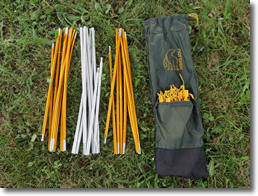 |
 |
 |
 |
 |
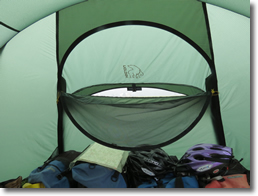 |
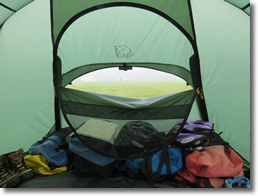 |
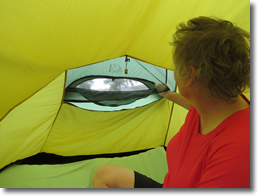 |
 |





































 The Celtic Cycling Circle
The Celtic Cycling Circle Cycling alongside the Grand Union Canal
Cycling alongside the Grand Union Canal 5 Essential Items to Take with You on Your First Cycling Tour
5 Essential Items to Take with You on Your First Cycling Tour Favorite Cycling Destinations: Sardinia
Favorite Cycling Destinations: Sardinia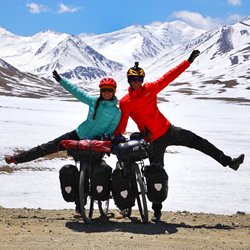 Pamir to Karakoram- cycling the highways on the roof of the world
Pamir to Karakoram- cycling the highways on the roof of the world 4 Wheels 2 Hearts 1 World - A Day in Our lives
4 Wheels 2 Hearts 1 World - A Day in Our lives Koga E-Worldtraveller - e-bike review
Koga E-Worldtraveller - e-bike review Ten tips for tandem cycle touring
Ten tips for tandem cycle touring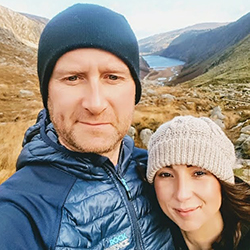 colmandsamstreks - Two Beginners in France
colmandsamstreks - Two Beginners in France